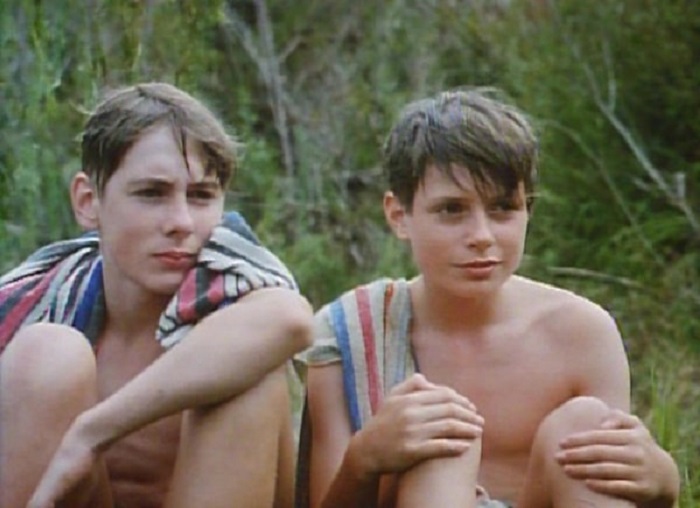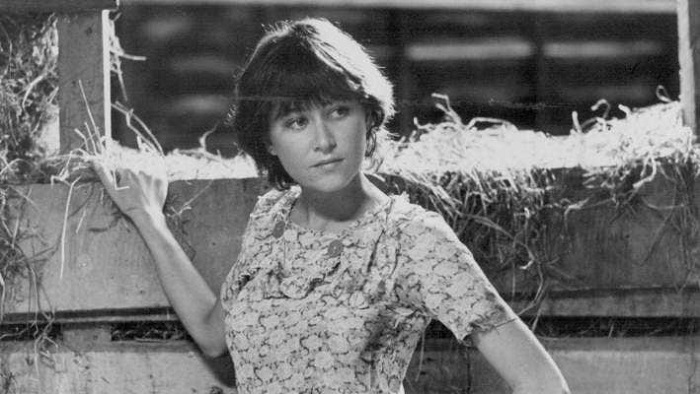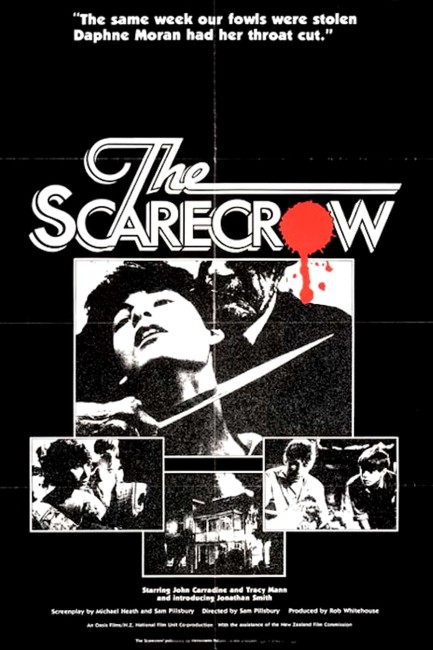aka Klynham Summer
New Zealand. 1982.
Crew
Director – Sam Pillsbury, Screenplay – Sam Pillsbury & Michael Heath, Based on the Novel The Scarecrow (1963) by Ronald Hugh Morrieson, Producer – Rob Whitehouse, Photography – James Bartle, Music – Phil Broadhurst, Andrew Hagen & Morton Wilson, Special Effects – Kevin Chisnall, Production Design – Neil Angwin. Production Company – Oasis Films/New Zealand Film Commission/National Film Unit.
Cast
Jonathan Smith (Ned Poindexter), Tracy Mann (Prudence Poindexter), John Carradine (Hubert Salter), Daniel McLaren (Les Wilson), Philip Holder (Constable Len Ramsbottom), Greg Naughton (Victor Lynch), Bruce Allpress (Uncle Athol Cudby), Des Kelly (Daniel Poindexter), Anne Flannery (Natalie Poindexter), Jonathan Hardy (Charlie Dabney), Martyn Sanderson (Adult Ned’s Voice)
Plot
The small New Zealand town of Klynham in the 1950s. Teenager Ned Poindexter and his friend Les decide to start raising chickens, only to have their chickens stolen. They steal them back from the person they believe to be the thief, only for Ned’s alcoholic Uncle Athol to be suspected by the police. At the same time, girls in the town are suddenly being killed. Ned suspects that the killer is the sinister Hubert Salter who has just arrived in town and taken up residence at the undertaker’s place. Ned also begins to fear that his older sister Pru, who is starting to ‘cut loose’ and rebel against their parents and take an interest in boys, may become Salter’s next victim.
The frequent dark, sexual obsessions of novelist Ronald Hugh Morrieson are probably the nearest thing that New Zealand has to a homegrown horror writer. Morrieson led a strange life, living and working mostly as a music teacher in the nowhere town of Hawera all his life. He began publishing with The Scarecrow (1961) and only published one other book Came a Hot Friday (1965) before his death at the age of 50 in 1972. Two further novels, Predicament (1975) and Pallet on the Floor (1976), were published posthumously.
All of Ronald Hugh Morrieson’s work centres around the banality of smalltown New Zealand where he cuts a lively cast of rough diamond provincials, but where a perpetual sense of disturbed sexuality, rape and murder lurk underneath. Several of his works have been filmed, including a rather dour version of Pallet on the Floor (1984), the more overtly knockabout adaptation of Came a Hot Friday (1985) about a racetrack confidence scam and Predicament (2010), another Coming of Age tale. The Scarecrow is the best of the films adapted from Morrieson’s work.


In the film, the original story is preserved fairly accurately. The cast do a fine job of filling out the offbeat characterisations, with some wonderful performances from Philip Holder as the constable awkwardly trying to manage polysyllabic words, or Greg Naughton’s toy town tough and gang of heavies falling over themselves dreaming of what they would like to do to Pru. It is all mounted with impeccable artistry – from the jaunty sax score that bounces around then turns delightfully, unexpectedly sinister for Salter’s appearances, to cinematographer James Bartle’s lovely plays of light and shadow.
Director Sam Pillsbury, in his big screen debut, shows off to an excess of style at times. He and Bartle set up some beautiful shots – John Carradine outlined in smoke from the train in an electric blue light, or the burial of Pru’s friend silhouetted against the horizon of a hill and a bleakly, moody grey sky. That said, Pillsbury is not particularly interested in the horror elements – his greatest forte is the eccentric characters and the handling of actors, especially so when it comes to Tracy Mann and the way he opens the film out, almost conducts an innocent courtship with her charmingly free performance.
Veteran horror actor John Carradine has never been better. Indeed by 1982, Carradine, then aged 76, had lapsed heavily into alcoholism and would die six years later. His parts in American films around the same time were the Z-grade likes of Satan’s Cheerleaders (1977), Nocturna, Dracula’s Granddaughter (1978), Vampire Hookers (1978) and assorted Al Adamson films. Here however he gives one of the best performances of his career as the sinister Salter. Pillsbury knows how to turn him into a scary presence and there are some wonderfully sinister scenes, like where he hypnotises Pru with the glittering light off a sword or conducts a magic trick with somebody’s glass eyeball in an empty pub. Alas, the story mishandles Carradine and never gives him centre stage – he is off-screen far too much. Indeed, The Scarecrow‘s problem is that it suffers from a rare form of cinematic excess – too much of a good thing – the subplots and character sketches dominate the plot to the point of confusion. Even the climax only takes place in a flashback afterwards.
Sam Pillsbury’s career since The Scarecrow has remained disappointingly undistinguished. He co-wrote Geoff Murphy’s end of the world drama The Quiet Earth (1985) and then made Starlight Hotel (1987) about hoboes during The Depression. Pillsbury then went to the US where he made the erotic film Zandalee (1991) and Free Willy 3: The Rescue (1997), before returning to NZ for the Maori drama Crooked Earth (2001). Other minor US films have followed with the likes of Morgan’s Creek (2001), Where the Red Fern Grows (2003) and Endless Bummer (2009). In between, Pillsbury has made mostly dreary US tv movie fodder, including the Western horror anthology Into the Badlands (1991), The President’s Daughter (1992), Knight Rider 2010 (1994), Fifteen and Pregnant (1998) and The Wedding Dress (2001).
Full film available here

